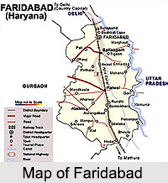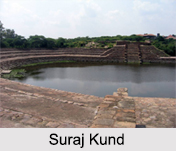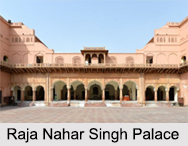 The city of Faridabad is a municipal corporation in the Faridabad district of Haryana and is a leading industrial hub of the state. Surveys conducted by the City Mayors Foundation states that Faridabad is the eighth fastest growing city in the world and third most in India. The Government of India has also included it in the list of Smart Cities Mission. The newly developed residential and industrial part of Faridabad between the Agra Canal and Yamuna River is commonly referred to as the Greater Faridabad. The area is being developed as a self-sustained sub-city with wide roads, tall buildings, malls, educational institutions, and health and commercial centres. The official languages spoken in the state are Hindi, Haryanvi and Punjabi. Recently, in 2018, Faridabad has been considered by the World Health Organisation as the world"s second most polluted city.
The city of Faridabad is a municipal corporation in the Faridabad district of Haryana and is a leading industrial hub of the state. Surveys conducted by the City Mayors Foundation states that Faridabad is the eighth fastest growing city in the world and third most in India. The Government of India has also included it in the list of Smart Cities Mission. The newly developed residential and industrial part of Faridabad between the Agra Canal and Yamuna River is commonly referred to as the Greater Faridabad. The area is being developed as a self-sustained sub-city with wide roads, tall buildings, malls, educational institutions, and health and commercial centres. The official languages spoken in the state are Hindi, Haryanvi and Punjabi. Recently, in 2018, Faridabad has been considered by the World Health Organisation as the world"s second most polluted city.
History of Faridabad
Founded in 1607 AD by Shaikh Farid, Emperor Jahangir"s treasurer, Faridabad is a south-eastern town and is one of the oldest towns in Haryana. The history of Faridabad dates back to the time when the city was formed with the object of protecting the highway, which passed through the town. Being a project for Pakistani refugee resettlement after the partition, light industrial development was initiated in the town in 1950. Now famous for its tourist resorts, it is known that the refugees laid down the initial infrastructure of the present Faridabad.
Demographics of Faridabad
As per the reports of Census India 2011, the total population of the city was 1,809,733 out of which male and female were 966,110 and 843,623 respectively. The average literacy rate of the city was 83.04 percent out of which the male literacy was higher than that of female at 88.61 percent and 73.84 percent respectively.
 Climate of Faridabad
Climate of Faridabad
The city of Faridabad has a borderline hot semi-arid climate which is just short of dry winter humid subtropical climate. The warm or pre-monsoon season lasts from late March to June at an average temperature of 34.2 degree Celsius. At an average temperature of 14.4 degree Celsius, January is the coldest month in the year. Precipitation is the lowest in April, with an average of 3 mm. In August, the precipitation reaches its peak, with an average of 188 mm. The city receives an average annual rainfall of 604 mm.
Tourism in Faridabad
Listed below are the names of few of the popular tourist destinations of the city of Faridabad.
Suraj Kund: Resembling a Roman amphitheatre, Suraj Kund is actually a water tank and is believed to have been constructed by the Tomar king Surajpal, who is largely believed to be a bardic tradition king. It dates back to the pre-Islamic period, and presents a remarkable example of contemporary Hindu architecture. The shape of Suraj Kund resembles the rising sun and literally means the Lake of the Sun. It is an artificial reservoir built in the backdrop of the Aravalli Range and has acclaimed fame over the years for its annual Suraj Kund International Crafts Mela. In 2018, it was the 32nd year of the fair which is usually celebrated from 1st of February till 15th February. The fair showcases Indian handicrafts, handlooms and folk traditions and comes alive with truly exotic, exquisite and exclusive ethnic items that range from delicately embroidered fabrics, hand woven furnishings, terracotta artefacts, jewellery, metal and cane-ware.
 Anangpur Dam: Situated about 2 km south of Suraj Kund, the Anangpur Dam is ascribed to Anangpal Tomar of the Rajput Tomara dynasty. It is battered on the east and has steps on the west with angular flaked steps on the southern and northern extremities. The dam stands at an elevation of 19.8 m with a length of 101 m. At the varying depths, from the top of the dam, there are 7 drainage channels that run through the thickness of the dam and were designed to maintain the appropriate levels of water in it. The steps of stairs are made of ashlar block stone laid in lime but in appearance they resemble the rubble core.
Anangpur Dam: Situated about 2 km south of Suraj Kund, the Anangpur Dam is ascribed to Anangpal Tomar of the Rajput Tomara dynasty. It is battered on the east and has steps on the west with angular flaked steps on the southern and northern extremities. The dam stands at an elevation of 19.8 m with a length of 101 m. At the varying depths, from the top of the dam, there are 7 drainage channels that run through the thickness of the dam and were designed to maintain the appropriate levels of water in it. The steps of stairs are made of ashlar block stone laid in lime but in appearance they resemble the rubble core.
Raja Nahar Singh Palace: This beautifully maintained palace of the legendary Raja Nahar Singh dates back to the 18th century AD. The earliest parts of Raja Nahar Singh"s palace were constructed by his ancestor Rao Balram, who came to power in 1739. This construction continued in parts till about 1850. Today, urban centres have come up around the palace. But, the beauty of the palace continues to charm the visitors.
Visiting Information on Faridabad
The nearest is the Indira Gandhi International Airport, New Delhi which is 31 km away from Faridabad and the closest railway station is the Hazrat Nizammudin Railway Station at New Delhi which is at a distance of 25 km.



















